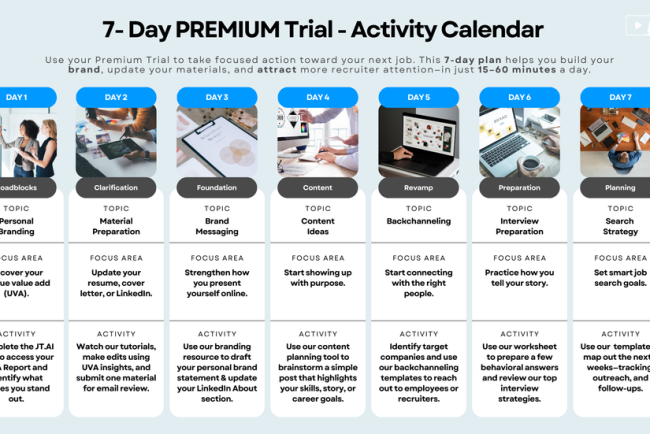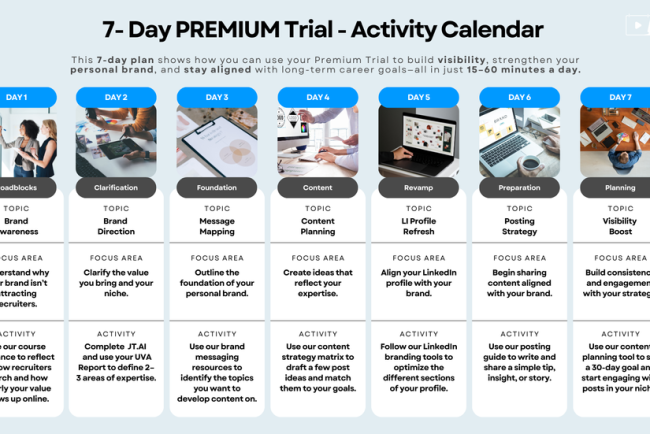
by Admin
5 Tips For Developing Good Leadership Skills
Perhaps the most intimidating aspect of leadership is knowing that, in addition to playing an important role in a team’s success, leaders are held responsible for their team’s failures. In order to obtain great results from their teams, leaders must be able to consistently motivate […]
Career development
by Admin
7 Vital Habits Of The Successful Professional
Who isn’t a little curious about what a successful professional does differently from the average person? It’s not about what they do with their money. It’s how they approach their careers. Passenger or Pilot: Which One Are You? It’s easy to think we are all […]
Career development
by Admin
How To Escape The One-Job Trap In 30 Days
I’m going to tell you something that might be hard to hear: if you’re still relying on one job to define your career and secure your future, you’re walking toward a cliff. Over two decades ago, I walked away from corporate America because I didn’t […]
Career development


Top 6 Tips For Resume Formatting
by Admin
Resumes are still the main “calling card” used by job seekers, and there are various schools of thought about the formatting of this document. Whether you’re entering the job market for the first time or re-entering after a career break, resume formatting plays a critical […]
Career development
Resumes are still the main “calling card” used by job seekers, and there are various schools of thought about the formatting of this document. Whether you’re entering the job market for the first time or re-entering after a career break, resume formatting plays a critical role in making a strong first impression. A well-formatted resume not only highlights your experience and skills but also ensures your application passes through applicant tracking systems (ATS) and gets noticed by recruiters and hiring managers.
Optimizing your resume format can boost your visibility and help recruiters quickly identify you as a strong candidate.
Here are a few tips for formatting your resume that may help you beat the blank screen blues if you’re creating a new resume from scratch (or updating one you haven’t touched in years):
1. White Space Is Important

Most resumes have at least a half-inch margin, but a full inch is preferable. If your margins are smaller, you risk losing content if the document is printed by the hiring manager. Plus, a resume that lacks a one-inch margin is harder for the reader to peruse and may look cluttered or chaotic—two qualities that are not often sought by employers.
Readability is key when formatting your resume. Keep this in mind if you’re using a resume template or adding bullet after bullet of new information to your already-existing resume. It’s a delicate balance between too much and too little information. Never underestimate the power of white space in your resume.
2. Don’t Leave Empty Fields

If you’re going to use a resume template, ensure all of the fields are completed with your personal information. Nothing looks worse than seeing “insert job information here” on a candidate’s resume. A glaring resume mistake like this may tell the hiring manager you lack attention to detail or other basic skills needed for the job.
The better choice may be to look at a variety of resume formats and combine styles based on your level of experience, knowledge, skills, and abilities. At Work It DAILY, we recommend using our six-second resume format, which you can have a career coach review before you apply for jobs.
3. Use Spellcheck & Have A Human Edit Your Resume

Spellcheck is great, but it doesn’t catch all grammatical and typographical errors. It’s helpful to have someone else review your resume. Ask for that person’s feedback on the style of your resume and the resume’s readability and content.
Where do their eyes look first? Did you quantify your work experience? Are your skills relevant to the position you’re applying for? Does the resume prompt them to want to learn more about you and your qualifications?
A good resume format doesn’t mean a thing if you have spelling and grammatical mistakes. Having another person review your resume could save you from some embarrassing job search fails. It’s definitely worth the extra time and energy.
4. Cut The Fluff

Your resume should be clear and concise. Almost all people applying for jobs nowadays know how to use Microsoft Office programs and email, so there’s no need to have a technical skills section on your resume unless you have skills that set you apart from the competition.
There’s also no need to list “references available upon request.” If employers want to check your references, they will ask for them.
Resume fluff only hurts your chances of getting the job. Nowadays, it’s about quality, not quantity. A one-page resume with quantifiable accomplishments and work experience is always better than a two-page resume with irrelevant information.
So, cut the fluff and get clear on the value you bring to the table.
5. Be Consistent With Your Style

Keep fonts and font sizes the same throughout your resume. You should also consider using a similar heading on all pages of the document if your resume is more than one page. This is a good precaution in case the pages become separated.
Any inconsistencies will be distracting for the hiring manager. Choose a clean font, pick a font size, and keep the same style in each section of your resume, including section titles. Avoid using excessive formatting like underlining or bolding in random places (it can make your resume look unprofessional). Stick to a standard font like Arial or Calibri, and use a 10–12 point font size for the body text to ensure readability.
6. Determine If Your Page Length Is Appropriate
Most resumes are one to two pages. However, if you have more than 20 years of experience and/or a number of academic or professional publications, your resume may be longer.
Keep in mind that a longer resume doesn’t equal more review time by the recruiter or hiring manager. Your most important information should still be at the top of page one. This is where all your hard skills (and transferable skills) should be, as well as your most relevant work experience.
When in doubt, ask yourself if the information you want to include on your resume makes you a better candidate for the job. If not, it’s probably not relevant to the position and can be removed.
Resumes are not static documents, so even if you think you’re finished with crafting a great one, you will want to revise and customize it slightly for each job you are applying for and add to it as you obtain more experience. Since more and more recruiters are using social media, you will also want to update your LinkedIn profile to match your new resume.
With the right resume format, you’ll catch the eye of hiring managers everywhere. We hope you use these resume formatting tips during your next job search. You’ll be surprised by how much of a difference it makes.
Need more help with your job search?
Get access to our Free Resource Center today (no credit card required!).

by Admin
Automation and the future of work (Presentation in the Sherwood Observatory)
Yesterday I had the opportunity to visit Sherwood Observatory as part of a meeting of local government, business and education stakeholders. We spent the morning talking about AI, automation and the future of work. We really benefitted from input from Professor Amin Al-Habaibeh from Nottingham […]
PresentationsYesterday I had the opportunity to visit Sherwood Observatory as part of a meeting of local government, business and education stakeholders. We spent the morning talking about AI, automation and the future of work.
We really benefitted from input from Professor Amin Al-Habaibeh from Nottingham Trent University who is an AI researcher. I was really struck by the way that he was able to describe the real impacts that AI could make on business efficiency and performance. But, I was also struck by the fact that these were detailed and bespoke developments within the context of specific businesses and business processes. AI is clearly not a magic cure-all, and it remains critical to keep human beings in the loop, particularly during development. The reality of AI is some way away from the rhetoric it seems.
I also made a contribution where I talked about the likely impacts that AI and automation will have on the labour market and careers. This is what I had to say…

by Admin
8 Mistakes Companies Make During Layoffs
I read this article by Forbes magazine on the subject of delivering bad news and realized just how many companies fail to follow the steps outlined when they lay people off. I honestly believe the majority of corporations and management teams don’t mean to do […]
Career development
I read this article by Forbes magazine on the subject of delivering bad news and realized just how many companies fail to follow the steps outlined when they lay people off. I honestly believe the majority of corporations and management teams don’t mean to do this incorrectly—they just haven’t been trained in what it takes to effectively communicate what’s happening. The result is an angry, vocal group of ex-staff members and a concerned set of clients who wonder if they should look for a new vendor.
Here’s the simple truth: Poorly handled layoffs don’t just damage employee morale. They can also tarnish a company’s brand, disrupt operations, and lead to long-term reputational harm.
Nowadays, layoff mistakes are often made public within hours, triggering negative press, backlash on social media, and even loss of business. It’s never been more important for leadership teams to understand best practices for managing workforce reductions with transparency, empathy, and professionalism.
Here are the most common mistakes companies make during layoffs:
1. Blindside Staff
I once worked at a start-up company that, unbeknownst to the staff, was running out of funds. So, one day we walked in and saw that, at 10:00 a.m., a large group of people got up from their desks and went to the cafeteria for a meeting. The other large group got up and went to the conference room.
Each had been sent an email on where to go. When they got to their respective meetings, the cafeteria group was told they were all being let go and to get their things, head home, and the company would be in touch with final pay. The other group was held hostage in the conference room and told they had to stay there until the layoff was complete. Needless to say, the fallout from that experience was significant.
2. Delaying The Inevitable

I’m working with a woman right now whose company announced a layoff five months ago after they were bought out and merged with a larger firm. Absolutely nothing has happened since.
She says the staff morale is at an all-time low. People feel paralyzed. They don’t want to look for a new job if they don’t have to, but they also don’t want to walk in one day and find out it’s over. Productivity is down, and stress-related illness is up from the fear of the unknown.
3. Covering Up The Truth

I have a friend who worked for a larger, privately held company. One day, he walked in and learned the company was “cutting expenses” and laid off 20% of the staff. At the time, he thought he was lucky because he kept his job.
A month later, news came out that the owner of the company was going through a messy divorce due to cheating on his wife and had been using company funds to support his mistress. The layoffs were a way to save money so he could pay himself more to cover the alimony payments while still maintaining his current lifestyle. My friend found a new job, along with several of his colleagues who couldn’t stomach working for the owner after that.
4. No Justifiable Explanation

Some companies announce layoffs due to “a decline in sales,” only to show an increase in earnings for shareholders in the same quarter. This sends a very confusing message to the world. You are making more money, so you are laying people off?
The best companies are clear as to why they are laying off, even if the reason is unpopular. If you feel appeasing shareholders is more important than keeping people employed, then say so. You might catch a lot of heat for your choice, but at least you won’t look like a liar.
5. No Support For Those Affected

Now that so many companies have conducted layoffs, it appears that HR departments and management teams have decided to scale back what they spend on outplacement programs (a.k.a. career coaching for those affected by the layoff). And while their lack of effort to help those who have been working for them usually doesn’t make the national news, it does spread like wildfire through the social community.
Today, layoff victims have a large platform for tarnishing the reputation of a former employer who throws them out on the street without help: social media. Companies shouldn’t underestimate the negative impact of failing to give proper resources to layoff victims will have on their reputation.
6. Not Addressing All Parties Involved

Some companies don’t feel they have to explain their reasons for laying off staff to anyone but those affected. What they forget is that anyone involved with their company is affected! For example, employees who don’t get let go have to deal with survivor’s guilt. It’s not as if they won’t ever see or hear from their former colleagues ever again. So, what should they do? And, no matter how hard you try to hide it, customers will hear about the layoffs. Would you rather they hear about it from a disgruntled ex-employee or from you personally?
In a time when transparency in business is being demanded, companies cannot afford to ignore their communication responsibilities to all parties involved. Otherwise, you can expect to lose the trust of the very people you need on your side to see through these challenging times for your business.
7. Fail To Provide Progress Reports

After the deed is done and the employees are let go, many companies try to rush back to “business as usual.” Well, that doesn’t work. Why? Because the layoff fundamentally changed your business, so there is no going back to the way it was.
Instead, companies should offer weekly progress reports to show those who are still with the company the ongoing efforts they are making to ensure the decision to lay off workers will, in the long run, be the right thing for both the business and them. You don’t stop the communications until you reach the point where you can show proof of success (i.e., stopped losing money, stabilized budget, etc.). At which point, you announce the new game plan to get the company back to its former glory.
8. Not Treating People With Respect After They Are Let Go

This is by far the most important. I’m amazed at how many companies let people go and then try their hardest to distance themselves from them. Example: A company I know laid off 2,000 people recently. Not only did they not give them any outplacement services, but they also decided they would not allow anyone at the company to be a reference for those who were let go. As a result, the 2,000 workers had no way to give potential employers a reference to prove they were part of an RIF (reduction in workforce).
The company stated that, given the size of the layoff, employers would know about it and wouldn’t need references. Well, anyone in HR knows that these days references are very important. The company even went so far as to tell the employees who remained that if they got caught giving a reference, they would be fired. The 2,000 workers were forced to use an automated telephone line that would verify pay and dates of employment as a reference instead. This created a lot of challenges for those workers who had been with the company for many years, since they honestly had no live references they could provide during their job search.
Sharing This Article Will Help Future Layoff Victims!

I hope managers who are reading this article tuck it away so they can use it as a guide if the day comes when they need to conduct a layoff. I also hope anyone who has been affected by a layoff passes it along to their management team.
Given how little training there is in conducting effective layoffs, we need to get corporate leadership up to speed on the right way to handle such a difficult situation. History shows that companies that manage the delivery of bad news and the need for change effectively are the ones that survive. So, the more senior management teams who read this and opt to follow the guidelines, the better, right?
Do your part to educate your leadership team—send them a link to this article today!
Looking for outplacement services for your former employees?
Check out Work It DAILY’s career coaching services today! My team and I are looking forward to working with you soon.

by Admin
How To Answer Any Behavioral Interview Question In 2025
We’ve gotten a lot of questions lately about interviews, which is a good thing because it means our readers are putting in the work and getting interviews (So, kudos to you!). But what we want to talk about today is a very particular type of […]
Career development
We’ve gotten a lot of questions lately about interviews, which is a good thing because it means our readers are putting in the work and getting interviews (So, kudos to you!). But what we want to talk about today is a very particular type of interview question that hiring managers are increasingly asking these days. This kind of question—a behavioral question—can be a curveball.
Behavioral interview questions are designed to assess how you’ve handled specific situations in the past, helping employers predict how you might perform in the future. In 2025, mastering behavioral interview questions is more important than ever, especially with employers placing a greater emphasis on emotional intelligence, problem-solving skills, and adaptability.
So, let’s get started by talking about what a behavioral question is.
What Is A Behavioral Interview Question?
A behavioral interview question is a special type of question. It’s one that requires more than a one-word answer. It’s the type of question where you are not going to respond with just a “yes” or “no.” In contrast, you’re going to have to elaborate in order to deliver an answer properly.
For example, a behavioral question would look something like, “Tell me about a time when you had to do X or Y…” You’re going to see these questions all the time during interviews because it helps the hiring manager get inside your head and understand how you approach and tackle certain problems.
Remember, an employer wants to make sure that you’re the right fit for the job. It’s not just that you have the experience. It’s also that you have the aptitude and the know-how to apply that experience so that you can do the job successfully in the way that you need to do it. This is what makes them feel comfortable with you as a hire, and all of this has to come out in your answer.
Now that you understand what a behavioral interview question is and why it’s so important to answer it thoroughly and correctly, I’m going to give you a methodology you can use to answer each and every behavioral interview question effectively. It’s called the “Experience + Learn = Grow“ model.
It’s a system we’ve designed that allows you to come up with answers that give the employer exactly what they want to hear.
How To Answer A Behavioral Interview Question

Step 1: Outline an experience that you’ve had that explains why you can do what they’re asking you to do.
Step 2: Talk about what you learned from that experience—how it made you smarter and better in your job.
Step 3: Talk about how you grew as a professional so that you can take that experience and use it to your advantage going forward.
When you answer behavioral questions using the “Experience + Learn = Grow” model, you’re mentally taking the hiring manager through the process they need to go through to come to the conclusion that you can do the job. This method not only showcases your skills and competencies but also highlights your ability to reflect, adapt, and improve. Mastering this approach will help you stand out in this highly competitive job market, where employers are looking for candidates who can demonstrate real-world problem-solving and resilience.
It’s also important that you ask good questions in an interview in order to make a great impression. Thoughtful questions show you’ve done your research, are genuinely interested in the role, and are evaluating if the company is the right fit for you—all key strategies for succeeding in behavioral interviews in 2025.
Example Of A Behavioral Interview Question & Answer

So, here’s an actual example of a typical behavioral question that you might get asked in your next interview:
“Tell me your greatest accomplishment on the job.”
Now, again, if you are going to use the “Experience + Learn = Grow” model here, you have to share enough information for the hiring manager to fully understand that you are capable of doing the job.
Let’s say you’re a customer service representative. Your answer might be:
Experience: “Well, as a customer service representative, the greatest accomplishment I ever had was learning how to deal with difficult customers. I remember a time when I got a call from a really angry customer. We had double-charged her, and she was irate. She was swearing at me and yelling at me on the phone. She was completely out of control, and I didn’t know what to do.”
Learn: “But I realized that if I stepped back for a second and didn’t take what she was saying personally, I could recognize how she was feeling. I could put myself in her shoes. So, I was able to do that. And in doing so, I was able to calmly address her needs, figure out what was going on, get her a credit, and really exceed her expectations. When it was all said and done, she was totally calmed down. She was apologetic for her behavior—for swearing at me—and most importantly, she was grateful and even gave me a four-star review afterward.”
Grow: “That really taught me the power of patience and empathy. When I’m talking to customers now, every time I get a difficult customer, I’m able to immediately go into that empathy mode so that I can give them a great customer service experience.”
Do you see how that answer followed the “Experience + Learn = Grow” model? By taking the time to map out your answers to questions like this, you can really make sure that you’re covering your bases and helping the hiring manager understand just how effective you can be in the job.
There are lots of behavioral questions that you can get asked in an interview. In fact, at Work It DAILY, we have a list of 18 potential questions that we take our clients through. To give you an idea of some other ones that you might come across, here are two more that you should be prepared to answer:
- “What would your co-workers say about you if we asked them?”
- “Tell me about a time when you got a difficult and unrealistic request from somebody, but they were really enthusiastic about it. What did you do?”
Those are just a couple more examples of the types of behavioral questions you can get asked, which again require much more than a typical one-word answer.
Most importantly, the “Experience + Learn = Grow” structure helps you consistently deliver the right answer at the right time! By using this simple formula, you can confidently navigate any behavioral interview question in 2025, no matter how complex it seems. Remember, behavioral interviews are designed to reveal your potential. Make sure your answers reflect the professional you are becoming.
Need more help with your job search?
Get access to our Free Resource Center today (no credit card required!).

by Admin
6 Ways To Show Your Value (Without Being A Jerk)
Team dynamics can often be difficult to negotiate. At work, generally speaking, you are on a team and you contribute. The problem is that you also want to elevate your career and stand out to your boss. So, how can you do that without the […]
Career development
Team dynamics can often be difficult to negotiate. At work, generally speaking, you are on a team and you contribute. The problem is that you also want to elevate your career and stand out to your boss. So, how can you do that without the rest of the team feeling like you are a jerk (or worse)?
I’ve had the gift of working in amazing environments on rock star teams. I have also had the (ahem) opposite experience. I’ve managed teams, been part of teams, as well as been an individual contributor, and through these years, I’ve found there are a few surefire ways to show you’re an asset without being a show-off.
Here’s how you can effectively show your value at work (without being a jerk):
1. Do What You Say
My favorite direct reports were good for their word. They were trustworthy. You could truly count on them to deliver, and not just for me. I would see these team members always doing what they said they would. People notice. It might not seem like it, but when you do what you say, you will get the important assignments.
Being the one who does the important stuff is viewed as valuable, and you’re valuable without being a jerk. You’re the good guy that people can count on to get stuff done. That kind of reliability builds a strong professional reputation, and in today’s competitive job market, reputation matters.
2. Solve Problems

The people who come to me with solutions stand out. Problem solvers who are actively working on solutions to organizational challenges stand out for obvious reasons. They care about the problems of the company and are taking the time to solve them.
There is a big difference between people who solve problems and people who try not to create them. The problem solvers stand out. And when they include others in the solution, all the better, because they are showing me that they are leaders who can activate others to join the cause of solving the big problems we’re facing.
This kind of collaborative problem solving shows initiative, emotional intelligence, and leadership potential—qualities every employer is looking for. If you’re looking to show your value at work, start by identifying a challenge, rallying your peers, and proposing actionable steps.
3. Share In Victory

Further, managers know that a team builds a victory and solves a problem together. Good managers can also see who’s doing the lion’s share of the work and really contributing to the victory. If it’s you, be sure you are gracious in sharing that victory with the team—that stands out to good managers and to the team.
When you recognize your teammates’ efforts and highlight shared success, it shows emotional intelligence and leadership potential. This kind of professional maturity gets noticed during performance reviews and can set you apart for promotions. Demonstrating value at work is as much about uplifting others as it is about output.
4. Focus On The Mission

Be monomaniacal about achieving the goals of the company and the team. When you see the team headed down a rabbit hole, gently guide them back to land. Be the one who is focused on achieving the goals, and you will stand out.
You might be considered a jerk for being the one who asks for focus by the ones who are unfocused, but they will forgive you when you achieve the goals, solve the problems, and share the victory (see above).
5. Be A Trusted Resource

I frequently advocate being a student of your industry. This is applicable to standing out without being perceived as a jerk when you are sharing information with your teammates about the industry and the business. When you are the go-to for information and insights, you are going to stand out. However, if you do this in a smarty-pants spirit, you are on a slippery slope to Jerktown, population: 1.
Being a trusted resource means you are sharing information in the spirit of continuous learning and development. Share that you saw something interesting in the media about the company, competitor, or industry. And when you share this information, offer an insight and an invitation to hear what the recipient of this information thinks.
6. No Brag, Just Fact

If you do awesome work, it’s okay to privately share what you’re proud of with your manager—key word, privately. Schedule time to share your excitement with your manager. You should try to have monthly check-ins with your manager so that you can gather feedback and continue to advance your career.
Keep in mind when you are privately sharing your work with your manager, do it from a place of excitement and pride, not from a place of ego and braggery. Excitement is contagious. Your manager may also be able to help you take the work even further.
Remember, the key to showing your value without being a jerk is balancing confidence with humility. Follow the tips above to successfully demonstrate your value at work and build a strong professional reputation that will earn the respect of your colleagues.
Need more help showing your value at work?
Get access to our Free Resource Center today (no credit card required!).

by Admin
Maximize Your Job Search In 7 Days: How Our Premium Trial Sets You Up For Success
Job hunting can feel overwhelming, especially when you’re doing it alone (or receiving unsolicited, unhelpful advice from out-of-touch family members). Between resumes, interviews, and countless applications, it’s easy to feel stuck or unsure about where to focus your time. That’s why our 7-Day Premium Trial […]
Career development
Job hunting can feel overwhelming, especially when you’re doing it alone (or receiving unsolicited, unhelpful advice from out-of-touch family members). Between resumes, interviews, and countless applications, it’s easy to feel stuck or unsure about where to focus your time. That’s why our 7-Day Premium Trial was designed to help you take meaningful, strategic action toward landing your next job.
We know that job search success isn’t about luck; it’s about small, smart actions taken consistently. That’s why we offer a 7-day free trial of our services, so you can see the power of “working it daily” with the right job search strategies.
In just 15–60 minutes a day, you’ll build your personal brand, update your materials, and attract more recruiter attention. Here’s exactly what you can accomplish each day of your free trial:
Day 1: Uncover What Makes You Stand Out

Topic: Personal Branding | Focus Area: Unique Value Add (UVA)
Before you can market yourself effectively, you need to understand what sets you apart. On Day 1, you’ll complete the JT.AI tool to receive your UVA Report, which identifies your professional strengths and what makes you valuable to employers.
What you’ll gain:
- Self-awareness about your standout skills
- A strong foundation for your resume, LinkedIn, and interview answers
Day 2: Strengthen Your Application Materials

Topic: Material Preparation | Focus Area: Resume, Cover Letter, LinkedIn
Your job search tools should reflect your unique strengths. On Day 2, you’ll watch our expert tutorials, update your resume, cover letter, or LinkedIn using your UVA insights, and submit one document for a professional review.
What you’ll gain:
- Clear, keyword-optimized materials
- More confidence in submitting applications
- Personalized feedback from career experts
Day 3: Polish Your Brand Message

Topic: Brand Messaging | Focus Area: Online Presence
Consistency is key in your job search. On Day 3, you’ll draft your personal brand statement using our branding resource and update your LinkedIn “About” section to reflect who you are and what you bring to the table.
What you’ll gain:
- A cohesive personal brand
- A stronger LinkedIn presence that catches recruiters’ attention
Day 4: Share Your Story With Purpose

Topic: Content Ideas | Focus Area: LinkedIn Visibility
It’s not enough to have a great profile. You need to show up with intention, too. Use our content planning tool to create and share a simple post that highlights your skills, your story, or your career goals.
What you’ll gain:
- Increased visibility and engagement on LinkedIn
- More opportunities to be noticed by hiring managers and recruiters
Day 5: Make Strategic Connections

Topic: Backchanneling | Focus Area: Networking & Outreach
Most jobs are filled through referrals, not online applications. On Day 5, you’ll identify target companies (aka make an interview bucket list) and use our backchanneling templates to reach out to employees or recruiters directly.
What you’ll gain:
- A smarter networking strategy
- More meaningful connections at companies you care about
Day 6: Get Interview-Ready

Topic: Interview Preparation | Focus Area: Storytelling
Preparation is everything. Use our worksheet to draft answers to common behavioral interview questions and review our top interview strategies.
What you’ll gain:
- Ready-to-go responses using the “Experience + Learn = Grow” method
- Improved confidence and clarity in interviews
Day 7: Set a Smart Job Search Plan

Topic: Search Strategy | Focus Area: Planning & Tracking
Your job search needs structure to stay on track. On Day 7, you’ll use our template to map out your next two weeks of job search activities, including outreach, follow-ups, and application tracking.
What you’ll gain:
- A clear, repeatable system for job searching
- Reduced stress and better progress over time
One Week Can Change Everything
With just a little focus each day, our 7-Day Premium Trial helps you move from stuck and uncertain to strategic and empowered. Whether you’re actively applying or just starting to explore your next move, this plan gives you the tools and structure to take control of your career.
Ready to stand out, get noticed, and land more interviews?
Start your Premium Trial today and see what a difference a week can make.

by Admin
Unlock Your Career Growth In Just 7 Days: How To Maximize Your Work It DAILY Premium Trial
What if you could make real progress in your career…in just one week? At Work It DAILY, we know that the key to career growth is small, sustainable habits. Seven days of consistent effort might just be what you need to start growing your career. […]
Career development
What if you could make real progress in your career…in just one week? At Work It DAILY, we know that the key to career growth is small, sustainable habits. Seven days of consistent effort might just be what you need to start growing your career.
If you’re feeling stuck in your career, unsure how to move up the ladder, or ready to take your personal brand to the next level, the Work It DAILY 7-Day Premium Trial is your chance to take meaningful action. With just 15–60 minutes a day, you can build visibility, strengthen your professional brand, and align your efforts with long-term career goals.
Here’s how you can make the most of your free trial and transform your career growth strategy in just seven days:
Day 1: Identify What’s Holding You Back

Topic: Brand Awareness
Goal: Understand why your brand isn’t attracting recruiters.
What You’ll Do:
Use the Work It DAILY course guidance to reflect on how recruiters search—and how clearly your value is showing up online.
Why It Matters:
If you’re not showing up in recruiter searches or getting profile views, it’s time to uncover the blind spots in your online presence. Day 1 helps you diagnose the problem so you can fix it.
Day 2: Clarify Your Value and Career Direction

Topic: Brand Direction
Goal: Define what you bring to the table and pinpoint your niche.
What You’ll Do:
Complete the JT.AI assessment and review your UVA (unique value add) Report to highlight 2–3 core areas of expertise.
Why It Matters:
You can’t market yourself without knowing your value. Day 2 helps you articulate what sets you apart, which is critical for standing out in competitive job markets.
Day 3: Create the Foundation of Your Personal Brand

Topic: Message Mapping
Goal: Build the message behind your personal brand.
What You’ll Do:
Use our brand messaging resources to identify the topics you want to create content on that reflect your strengths, goals, and unique value add.
Why It Matters:
A strong personal brand isn’t built overnight, but it does start with a clear message. Day 3 equips you to speak (and post!) consistently and confidently about your career story.
Day 4: Turn Your Expertise into Content

Topic: Content Planning
Goal: Brainstorm content ideas that showcase your knowledge.
What You’ll Do:
Use our content strategy matrix to generate post ideas that align with your messaging and career goals.
Why It Matters:
Content builds authority. Whether you’re posting on LinkedIn or contributing to industry conversations, Day 4 helps you move from passive observer (invisible) to thought leader (visible).
Day 5: Give Your LinkedIn Profile a Strategic Makeover

Topic: LinkedIn Profile Refresh
Goal: Align your online presence with your personal brand.
What You’ll Do:
Follow our LinkedIn branding tools to optimize your headline, summary, experience, and skills sections.
Why It Matters:
Your LinkedIn profile is often the first thing recruiters see. Day 5 ensures that it leaves a strong, consistent, and strategic impression.
Day 6: Start Posting with Purpose

Topic: Posting Strategy
Goal: Share your first branded piece of content.
What You’ll Do:
Use our posting guide to write and share a short tip, story, or insight aligned with your niche.
Why It Matters:
Visibility comes from consistency. Day 6 gets you past the fear of posting and into action mode, so your audience (and recruiters) start noticing you.
Day 7: Set Your 30-Day Visibility Plan

Topic: Visibility Boost
Goal: Build a habit of engagement and content creation.
What You’ll Do:
Use our content planning tool to create a 30-day engagement goal with regular posts in your niche.
Why It Matters:
Momentum builds opportunity. Day 7 sets you up with a realistic and actionable strategy to keep showing up and growing your personal brand long after your trial ends.
Start Your 7-Day Transformation Today
In just one week, you can go from invisible to impactful. Whether you’re job hunting, positioning yourself for a promotion, or simply want to own your professional narrative, the Work It DAILY Premium Trial gives you the tools and structure to grow—fast.
- Understand your brand
- Define your value
- Build content that reflects your expertise
- Optimize your LinkedIn profile
- Create a visibility strategy that gets results
Ready to take control of your career?
Start your free 7-day trial and unlock the career growth you’ve been waiting for.

by Admin
How To Make Friends With Ambitious People
If you’re trying to take yourself and your life to the next level, it makes a lot of sense to aim higher when it comes to making friends. The right friends will support you emotionally and provide practical help along the way. Surrounding yourself with […]
Career development
If you’re trying to take yourself and your life to the next level, it makes a lot of sense to aim higher when it comes to making friends. The right friends will support you emotionally and provide practical help along the way.
Surrounding yourself with ambitious people is one of the fastest ways to grow, both personally and professionally. These individuals are driven, goal-oriented, and often deeply inspiring—qualities that can help you raise your own standards and stay focused.
If you have exciting friends who aren’t as ambitious as you are, chances are that they’re unconsciously holding you back. You don’t have to stop seeing them; your best bet is to focus on building friendships with new people. If you want to make friends with ambitious people, read on.
In this article, we would like to share with you three important steps. These steps will help you go to the next level in your social life, meet many ambitious and interesting people, and have them stick around for a long time.
Step #1 – Take Control Of Your Social Life (Don’t Leave It To Chance!)
People seem to leave their friendship life to chance, more often than not. While that probably worked well when you were a kid, it most certainly won’t work for you as an adult. With no college or school to facilitate new friendships, you need to be proactive about it. This means that you get conscious and curious about friendship and how it works—consciously make time, every week, for meeting new people, staying in touch, and hanging out with them.
Studies have shown that the influence other people have on you is strong; your destiny literally depends on the people you hang out with. This is why it’s important to have a clear idea of the kind of people you want to have in your life. All you have to do is make a general list of qualities, attributes, or activities that you want in your future friends. It doesn’t have to be definitive; it’s just a guide for your mind. You can start by listing qualities like “healthy,” “ambitious,” “honest,” “productive,” “fun,” “interesting,” etc.
Step #2 – Adopt These Winning Social Habits

Success in your friendship life means that you don’t only use the tips once in a while; it means that you adopt the easy new habits that will work on a consistent basis. The first habit is to go meet new people every month. The way to do that is to join a local community that meets up once or twice every month. Try a few that you can find on Meetup and decide on the one that has the kind of people you’d like to get to know better. In general, go where meeting people is easy; focus on places like trade shows, cultural or charitable events, seminars or talks, and so on.
The second habit is to dedicate at least one hour every week to reaching out to people in your network. You can put it in your calendar; it can be something like every Wednesday at 7 p.m. Early in the week is better. Contact and network with important/strategic LinkedIn connections during this hour. This habit will make sure you don’t lose touch with your existing friends, and follow up with the new people you meet.
The third habit is to decide what you’re going to do over the weekend ahead of time. When it’s time to reach out to people, plan ahead and decide on what you want to do; suggest that plan to those you want to see. This is why it’s important that you contact people early enough in the week, when they haven’t already decided what to do on Thursday, Friday, and Saturday.
Step #3 – Build A Social Circle

Making friends can be time-consuming if you don’t optimize your efforts. If you’re always the one calling and making plans, then you’re not going to be doing it for very long. The best way to tackle this is to focus on forming groups of friends instead of having a bunch of friends who don’t know each other. We recommend that you always introduce the people that you know to each other, especially if they’re of the ambitious kind. After they meet once or twice, a new group emerges, and you now have a circle of friends. When that happens, they start to call and make plans as well, which means you’ll have more time to contact and make plans with people that you don’t know that well.
As you meet new people, introduce them to the existing group, and make it bigger. If you prefer to meet in small groups, this is a great strategy as well; you can still meet two or three people at the same time, even if your social circle has dozens of people in it.
These three steps will get you started on having ambitious, resourceful friends who will help you succeed, introduce people to you, and emotionally support you when you need it. What’s really important is to open your mind to learning about friendship, how it works, and how you can apply that information to your life.
Need more help with your career?
Get access to our Free Resource Center today (no credit card required!).

by Admin
5 Ways To Instantly Improve Your Job Search Results
By now, you’ve probably learned that the traditional ways of job searching don’t work anymore. A few years ago, you could put your resume on multiple online job boards and wait for a promising email or phone call from an employer. Those days are gone. […]
Career development
By now, you’ve probably learned that the traditional ways of job searching don’t work anymore. A few years ago, you could put your resume on multiple online job boards and wait for a promising email or phone call from an employer. Those days are gone.
If you want to land your dream job, you have to be proactive. Today’s job market is fast-paced, competitive, and heavily influenced by technology (AI is here to stay). Simply having a great resume isn’t enough. You need a well-rounded job search strategy that includes networking, personal branding, and smart use of digital tools. Whether you’re just starting out or looking to make a career change, it’s essential to take control of your job hunt and stand out from the crowd.
Here are five basic strategies to follow that will help you improve your job search results:
Scan Your Resume For 15 Seconds
Recruiters read hundreds of resumes on a daily basis. They only have time to skim the top of them (aka the “top fold”), so if you don’t give a clear message about what you can do for them, then it is not a good resume. Since this is the most important document in your career, you need to give it the attention it deserves.
Start with a strong experience summary (a list of 6-8 hard or transferable skills needed for the specific job you’re applying for). Use keywords from the job description to ensure your resume passes applicant tracking systems (ATS). Make your achievements measurable and action-oriented to quickly demonstrate impact. Clean formatting, concise language, and a focus on results will help your resume rise to the top of the pile.
Focus On The High-Return Job Efforts

Job boards have less than a 5% effectiveness rate, while networking has over a 50% effectiveness rate.
Start by selecting your bucket list of companies where you would love to work. Do a company search on LinkedIn and identify the decision-makers and their staff. Then, see who you know who might know someone who can then make an introduction for you. Follow the company and connect with people on LinkedIn, join their groups and conversations, comment on their blogs, and become known.
This is called “backchanneling,” and it’s how you move from a passive job search, waiting for the right job to appear on the job boards, to a proactive one where you’re an active job seeker targeting the kinds of positions you really want.
Optimize Your LinkedIn Profile

If a recruiter were searching through LinkedIn to find people for the position you are seeking, would you show up? Try it, and if you are not on the first or second page, go back to your profile and optimize it with the right keywords to get yourself a higher ranking.
Focus on job titles, skills, and industry-specific terms that hiring managers commonly search for. Make sure your headline and “About” section clearly reflect the role you want, not just the one you have. Also, sprinkle in relevant keywords throughout your experience descriptions to boost your visibility in LinkedIn’s search algorithm.
Review Your Online Presence

Many employers will Google your name to learn more about you. Make sure you look good on LinkedIn and review your activity on Facebook, Instagram, and any other social media platforms. Take down or change any comments that reflect poorly upon you. Use your own blog, online exchanges, and testimonials to showcase your professional knowledge. Your social media plays a huge role in the job search process.
Hiring managers often look for consistency between your resume and your online presence, so be sure your profiles reflect your skills, experience, and career goals. Update your LinkedIn headline with relevant keywords for your target role, and consider sharing thought leadership content to build credibility. Try posting both written and video content on LinkedIn, proving your value and expertise. A well-managed digital footprint can boost your job search results and help recruiters find you faster.
Create Measurable Goals

Searching for a job is like any other project, and you must stay disciplined, so set firm goals for yourself. For example, “I will make 10 networking calls and have two meetings per week.” Make sure you are focusing on high-impact efforts like networking versus job board submissions. Keep a record of your efforts so that if an employer calls, you can quickly determine when and how they were contacted.
Clear, measurable job search goals help you stay focused and make daily progress (we’re called “Work It DAILY” for a reason!). Set targets for resume submissions, LinkedIn outreach, and informational interviews to build consistency. When your job search goals are specific and trackable, you’re more likely to stay motivated and avoid burnout. Prioritizing goal-setting in your job search strategy can drastically improve your chances of landing interviews faster.
Improving your job search results doesn’t have to be overwhelming. It just takes the right approach. By implementing these five strategies, you can take immediate control of your job hunt and start seeing better results. The job market may have changed, but your ability to adapt is your greatest asset. Stay consistent, stay visible, and, most importantly, stay confident. With a smart, modern job search strategy in place, landing your next great opportunity is just around the corner.
Need more help with your job search?
Get access to our Free Resource Center today (no credit card required!).

by Admin
7 Tips For Becoming A Successful Leader At Work
Becoming a successful leader at work can be challenging. You want to be the one your team looks to for guidance and support, but you may not be in a leadership role yet. So, can you establish yourself as a leader at work and display […]
Career development
Becoming a successful leader at work can be challenging. You want to be the one your team looks to for guidance and support, but you may not be in a leadership role yet. So, can you establish yourself as a leader at work and display the characteristics of a good leader daily?
There are many ways, but listed below are some things to start doing today. By doing these things, you can position yourself as a leader at work without being too obvious about your ambitions. Taking initiative, practicing effective communication, and staying consistent with your values are just a few ways to gain respect and credibility among your peers.
If you want to become a leader at work and develop your leadership skills, incorporate these actions into your daily routine. With time and persistence, you’ll start to build the kind of leadership presence that naturally inspires others and opens the door to future career growth.
1. Take On More Responsibility At Work

To become a leader at work, learn to take responsibility for anything that you’re interested in and own it. That also means that as long as you participate in that project, you influence whether it fails or succeeds.
Learn to take responsibility for not just the good things, but also the bad things. Take ownership of your mistakes, and know it’s okay to be wrong. You cannot learn if you haven’t made any mistakes.
By acknowledging where things went wrong and actively seeking solutions, you build trust with your team and demonstrate emotional intelligence, both key leadership qualities. Embracing accountability will set you apart as someone who’s not just involved but truly invested in becoming a successful leader at work.
2. Believe In Win-Win In The Workplace

A rising tide lifts all boats—always think win-win.
It exists. Just because some may believe the business world is nasty, and that you need to be manipulative and maneuvering to win, you need not participate in it. In fact, make it your priority not to be a negative and manipulative leader.
If you want to be a leader at work, believe in your positive leadership abilities. The positive influence you have on the people around you and the ability to inspire your team are right in front of you.
3. Strive To Push The Envelope

Try new things. Take some risks. Make yourself uncomfortable. Do the things that may make you look foolish. Seriously, what do you have to lose?
Leaders take risks. They are not afraid of doing what they believe is right. What are you willing to take a risk for? To be a leader at work, you need to take small risks, like taking on a project no one wants. Step up when others step back.
4. If You Have An Idea, Write It Down

I often say this world is full of people who talk too much and don’t do enough.
If you want to be a leader at work, act on something. Work on a plan. If you have ideas simmering in your mind, write them down.
It doesn’t matter if your idea doesn’t have a plan yet—just write it down. If you don’t write it down, there is no record of the idea, and you won’t have anything tangible to present. How can it count? If you want to be a leader at work, you have to practice writing down everything.
Strong leaders are proactive, not reactive. Writing down your thoughts helps clarify your vision and gives you a foundation to build on. It also shows initiative—something every successful leader needs to demonstrate consistently. Documenting your ideas is the first step in turning vision into action and action into leadership.
5. See Opportunities Everywhere

There is no need to create leadership opportunities at work. The opportunities to lead are everywhere already.
You need to be mindful of these opportunities. An example of an opportunity you can capitalize on is taking on a project no one wants. If you don’t see opportunities like this everywhere, you are missing the point.
Successful leaders don’t wait for a promotion or a title. They step up when challenges arise. Whether it’s volunteering to lead a meeting, mentoring a new team member, or improving an outdated process, these are real-world chances to demonstrate leadership. If you’re serious about becoming a successful leader at work, you need to train your mind to recognize and embrace these moments daily.
6. Be Open To Receiving Feedback

Be open to criticism. Otherwise, you are just living off your own opinions and ideas.
What does being open to criticism mean? When you are open to feedback, you are getting ideas and suggestions from others that are free. Oftentimes, these ideas come from people smarter than you. They will give you tips on how to improve and how to be better.
That’s what a leader needs—constant feedback. You need feedback to be a leader at work, otherwise you are “feed-own” (I just created that word to mean feeding yourself) and you will go hungry soon. With no new ideas, a leader dries up.
7. Give Your Work Everything You’ve Got

Giving is how you open up at work. Pour out all you got. Express your ideas, thoughts, and plans. Feel the vulnerability and learn to like it.
When you pour all your ideas out, you will need new ones. Where do new ideas come from? They come from critics, from well-meaning supporters, and from the people you least expect. At the end of the day, more comes back to you. You have more to input. It enriches you.
The workplace thrives on the free flow of ideas, and when you lead by giving, you encourage innovation and collaboration. Sharing builds trust, and trust builds influence. The more you give, the more you’re seen as someone people want to follow, which is key to becoming a successful leader at work.
These are the seven actions you can do starting today to position yourself as a leader at work. Remember, if you want to be an influential leader, do not be afraid of taking risks. You have more to gain than to lose when you open up.
Need more help with your career?
Get access to our Free Resource Center today (no credit card required!).



















